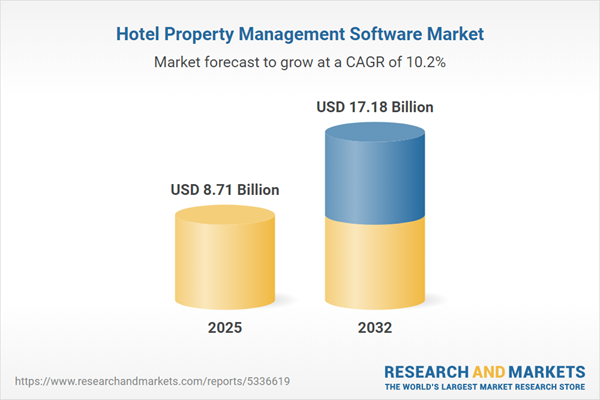Speak directly to the analyst to clarify any post sales queries you may have.
The hotel property management software market is rapidly evolving, propelled by rising guest expectations and increasing operational complexity. Senior decision-makers are embracing digital solutions that connect vital hotel functions, optimize workflows, and create agile, integrated platforms designed for modern guest journeys.
Market Snapshot: Hotel Property Management Software Market Growth & Outlook
The Hotel Property Management Software Market grew from USD 7.91 billion in 2024 to USD 8.71 billion in 2025. It is expected to continue growing at a CAGR of 10.17%, reaching USD 17.18 billion by 2032. This trajectory reflects increasing investments in operational automation, guest experience improvements, and the adoption of cloud-native architectures across diverse hospitality segments.
Scope & Segmentation: Comprehensive Coverage of Hotel Property Management Software Ecosystem
Upgrade operational resilience and guest satisfaction by leveraging solutions designed for specific industry needs. This report details nuanced segmentation, covering functions, property types, deployment choices, and regions for actionable market insights.
- Function: Booking engine, channel management, lease management, property accounting, property inspection, restaurant POS, revenue management, and room reservation.
- Type: Homestay accommodation, hotels and resorts (chain, large, medium, small, very large), lifestyle villages, marina, mobile home parks, motels and lodges, park and campground, serviced apartments.
- Subscription Model: Perpetual license, subscription-based.
- Software Type: Integrated, standalone system.
- Deployment: On-cloud, on-premises.
- End User: Boutique hotels, business hotels, resorts and spas.
- Region: Americas (United States, Canada, Mexico, Brazil, Argentina, Chile, Colombia, Peru), Europe (United Kingdom, Germany, France, Russia, Italy, Spain, Netherlands, Sweden, Poland, Switzerland), Middle East (United Arab Emirates, Saudi Arabia, Qatar, Turkey, Israel), Africa (South Africa, Nigeria, Egypt, Kenya), Asia-Pacific (China, India, Japan, Australia, South Korea, Indonesia, Thailand, Malaysia, Singapore, Taiwan).
- Company Coverage: Industry analysis spans providers such as Agilysys, AltexSoft, ASSD GmbH, Atulyam Hotelline, AxisRooms, Care Internet Services, Cisco Systems, Clock Software, Cloudbeds, eZee Technosys by Yanolja, Hallisoft, Hotelogix, Infor by Koch Industries, Salesforce, SAP SE, Shiji Group, Oracle Corporation, and others.
Key Takeaways: Strategic Insights for Senior Decision-Makers
- Cloud-native solutions are driving significant shifts, offering increased scalability, streamlined updates, and cost efficiency for operations of every size.
- Integrated platforms unify accounting, housekeeping, POS, and guest communication, transforming fragmented legacy systems into cohesive ecosystems.
- Market demand is expanding across boutique properties, urban hotel chains, luxury resorts, homestays, and serviced apartment segments, underscoring the need for configurable software.
- Open APIs and modular architectures enable seamless integration with CRM, revenue management, and third-party guest engagement platforms, increasing operational agility.
- Subscription and SaaS models are unlocking greater access and flexibility, while also minimizing upfront investments for hoteliers across global markets.
Tariff Impact: Navigating US Tariff Adjustments
New US tariffs on hardware components, including memory modules, network switches, sensors, and servers, are reshaping cost structures for property management technology deployments. This has accelerated migration to cloud-native and hybrid models, where service providers absorb physical hardware responsibilities and enable operators to hedge against cost volatility. Strategic planning and regional data center utilization offer further mitigation of these capital challenges.
Methodology & Data Sources
This research integrates secondary data, expert interviews, and quantitative validation. Analysts evaluated public filings, industry journals, and white papers, followed by interviews with hoteliers and IT executives. An online survey gathered practitioner feedback across property types and regions, supporting robust comparative analysis of vendor solutions and deployment models.
Why This Report Matters
- Enables leaders to benchmark technology strategies, optimize operational resilience, and future-proof guest experiences in a rapidly changing market.
- Equips decision-makers with rigorous insights on deployment options, integration frameworks, and regional best practices to inform investment and partnership choices.
Conclusion
Property management software innovation is transforming hotel operations through integration, flexibility, and responsiveness. Senior leaders who align strategy with market and technology imperatives will position their organizations for growth and competitive distinction in the global hospitality sector.
Additional Product Information:
- Purchase of this report includes 1 year online access with quarterly updates.
- This report can be updated on request. Please contact our Customer Experience team using the Ask a Question widget on our website.
Table of Contents
3. Executive Summary
4. Market Overview
7. Cumulative Impact of Artificial Intelligence 2025
Companies Mentioned
The companies profiled in this Hotel Property Management Software market report include:- Agilysys, Inc.
- AltexSoft Inc
- ASSD GmbH
- Atulyam Hotelline Solutions Pvt. Ltd
- AxisRooms Travel Distribution Pvt. Ltd.
- Care Internet Services B.V.
- Cisco Systems, Inc.
- Clock Software Ltd.
- Cloudbeds
- eZee Technosys Pvt. Ltd by Yanolja
- FCS Computer Systems
- Finner PMS
- GraceSoft, Inc.
- Hallisoft
- hoteliga international Sp. z o.o.
- Hotelogix India Pvt. Ltd
- HotelTime Solutions a.s.
- Huawei Technologies Co. Ltd.
- IDS Next Business Solutions Pvt. Ltd.
- Infor by Koch Industries, Inc.
- innRoad Hotel Management Software
- International Business Machines Corporation
- IRIS Software Systems Ltd.
- Johnson Controls International PLC
- Kipsu, Inc
- Lodgify
- Mews Systems B.V
- Nobeds
- OpenKey, Inc
- Oracle Corporation
- PROTEL Computer Inc.
- ResNexus
- Revinate
- Revpar Guru Inc.
- RMS Cloud
- RoomKeyPMS
- RoomRaccoon
- Salesforce, Inc.
- SAP SE
- Shiji Group
- Sirvoy Limited
- SiteMinder Limited
- Stayntouch Inc.
- ThinkReservations
- Valsoft Corporation
- WebRezPro
- Yanolja Co., Ltd.
Table Information
| Report Attribute | Details |
|---|---|
| No. of Pages | 183 |
| Published | November 2025 |
| Forecast Period | 2025 - 2032 |
| Estimated Market Value ( USD | $ 8.71 Billion |
| Forecasted Market Value ( USD | $ 17.18 Billion |
| Compound Annual Growth Rate | 10.1% |
| Regions Covered | Global |
| No. of Companies Mentioned | 48 |









